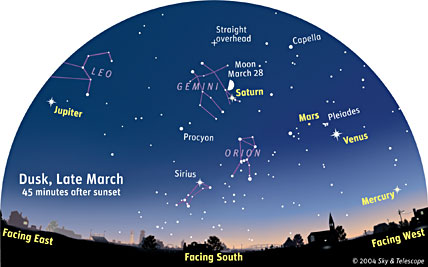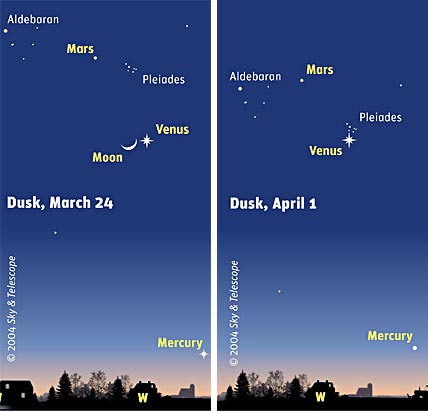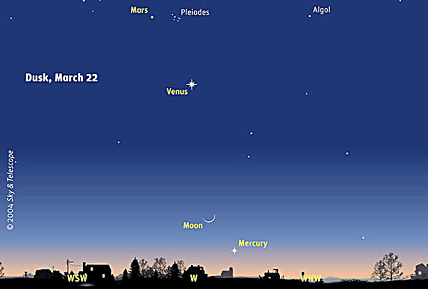March 18, 2004
Contact:
Alan MacRobert, Senior Editor
855-638-5388 x151, [email protected]
Note to Editors/Producers: This release is accompanied by a broadcast-quality animation and numerous publication-quality illustrations; see details on page 2.
For the next couple weeks, all five planets that are ever visible to the unaided eye shine at once during dusk. Moreover, the Moon and a prominent star cluster join the show as well, forming striking combinations in the early-evening sky.
"This is a special time for anyone who notices the sky," says Alan MacRobert, a senior editor of Sky & Telescope magazine. "You don't have to be any kind of great astronomer to enjoy this."
Sky & Telescope offers news media the following guide to the changing celestial scenery. (All descriptions are for midnorthern latitudes, such as those in the United States and southern Canada.)
Every Evening, March 19–31:
Spot All Five Planets
Look west as twilight fades on any clear evening, and there's dazzling white Venus. You can't miss it. Venus is the brightest point of light in the early-evening sky.
Look very far below Venus, and perhaps a bit to the right, to catch fainter little Mercury near the horizon. Be sure to look early (about 45 to 60 minutes after sunset) before Mercury gets too low and sets.
To the upper left of Venus, by roughly the width of your fist held at arm's length, you'll find fainter Mars, glimmering pale orange-red.
Three times farther to Mars's upper left is pale yellow Saturn. It's positioned high above the bright constellation Orion.
And Jupiter is the big, bright point of light shining high in the east-southeast. It's second in brightness only to Venus.
One-Day Events
 March 22: Crescent Moon and Mercury
March 22: Crescent Moon and Mercury
Look low in the west (far below bright Venus) as twilight fades to pick up the beautifully thin crescent Moon. Look to its lower right — and there's Mercury. Binoculars give a fine view.
 March 23: Moon under Venus
March 23: Moon under Venus
The crescent Moon shines below bright Venus in the west this evening, offering a foretaste of their beautiful conjunction (close pairing) tomorrow.
 March 24: Crescent Moon and Venus Grab the Eye!
March 24: Crescent Moon and Venus Grab the Eye!
The Moon and Venus are closely paired in the western sky this evening, a strikingly beautiful sight. "This is going to be a real head-turner," says MacRobert. "People will see this through their windshields driving home from work and say, 'What's that?'"
The Moon and Venus are the two brightest objects in the sky after the Sun. Binoculars will give an especially gorgeous view of them paired. This is also a good time to look for "earthshine" making the dark portion of the Moon glow dimly gray. Earthshine is sunlight reflected from the Earth onto the Moon's nighttime landscape — the same way a full Moon lights the ground on Earth at night.
As dusk deepens, look for fainter Mars to the upper left of the Moon and Venus, the star Aldebaran to the left or upper left of Mars (looking like its twin), and the Pleiades star cluster nearer to Mars's right. The cluster is about as big as your fingertip held at arm's length.
 March 25: Moon with Mars
March 25: Moon with Mars
As a coda to yesterday's Moon-Venus pairing, the Moon now pairs very closely with dimmer orange-red Mars — while Venus blazes brightly to their lower right.
 March 27: Saturn Left of the Moon
March 27: Saturn Left of the Moon
The Moon now pairs up with Saturn, the next planet east across the sky. Saturn is to the Moon's left. Look below them for the bright constellation Orion.
 March 28: Saturn under the Moon
March 28: Saturn under the Moon
Tonight you'll find the pale yellow point of Saturn shining beneath the Moon, which is now at first-quarter phase (half lit).
 April 1–4: Venus Meets the Pleiades
April 1–4: Venus Meets the Pleiades
Meanwhile, action has been developing in the west. During and after nightfall in the first few days of April, you'll see the little Pleiades star cluster positioned close to brilliant Venus. Again, binoculars give a wonderful view.
 April 2: Moon Shines with Jupiter
April 2: Moon Shines with Jupiter
Tonight the gibbous Moon shines close to bright Jupiter — the last of the five naked-eye planets that it meets — high in the southeast.
Warning: Objects May Appear
Closer Than They Are
As the Moon pairs up with each of these five planets, they'll look like they're close together. They are not. Here are the approximate distances of the Moon and its apparent partners during late March according to Sky & Telescope, given in both miles and light-times (how long their light takes to get here):
| Moon and Planet Distances in Late March 2004 | |||
| Object | Distance (miles) |
Distance (light-travel time) |
How Much Farther Than the Moon |
| Moon | 250,000 | 1.3 light-seconds | — |
| Mercury | 90 million | 8 light-minutes | 360× |
| Venus | 70 million | 6 light-minutes | 280× |
| Mars | 175 million | 16 light-minutes | 700× |
| Jupiter | 420 million | 37 light-minutes | 1,700× |
| Saturn | 830 million | 75 light-minutes | 3,300× |
| Pleiades | 2.4 quadrillion | 400 light-years | 10 billion times |
Sky & Telescope is making the following animation and illustrations available to the news media. Permission is granted for one-time, nonexclusive use in print and broadcast media, as long as appropriate credits (as noted in each caption) are included. Web publication must include a link to SkyandTelescope.com.

At dusk in late March 2004, all five naked-eye planets will be above the horizon at the same time. Venus and Jupiter are so bright they can't be missed. This simple sky chart will help you find fainter Mercury, Mars, and Saturn. Click on the image to download a publication-quality version (137-kilobyte JPEG) by anonymous FTP.
Sky & Telescope illustration.

Nightly from March 22 to April 4, 2004, there's a fine sky show playing in the west at dusk as the waxing Moon passes one planet after another and brilliant Venus moves past the Pleiades star cluster. A publication-quality illustration for each evening throughout this period is available by anonymous FTP. Each is a 75- to 80-kilobyte JPEG; click on a date to download the corresponding sky scene: March 22, March 23, March 24, March 25, March 26, March 27, March 28, March 29, March 30, March 31, April 1, April 2, April 3, April 4.
Sky & Telescope illustration.

This is a single image from a 14-frame animation showing the changing appearance of the dusk sky from night to night in late March and early April 2004. The animation is available in two sizes (428 x 289 pixels, as shown here, and 720 x 486 pixels) and in two formats (animated GIF and QuickTime) by anonymous FTP: small animated GIF (154 kilobytes); large animated GIF (370 KB); small QuickTime movie (152 KB); large QuickTime movie (338 KB).
Sky & Telescope illustration.
Sky Publishing Corp. was founded in 1941 by Charles A. Federer Jr. and Helen Spence Federer, the original editors of Sky & Telescope magazine. The company's headquarters are in Cambridge, Massachusetts, near the Harvard-Smithsonian Center for Astrophysics. In addition to Sky & Telescope and its Web site, SkyandTelescope.com, the company publishes Night Sky, a new bimonthly magazine for beginners, with a Web site at NightSkyMag.com; two annual magazines, Beautiful Universe and SkyWatch; an annual wall calendar called Celestial Wonders; as well as books, star atlases, posters, prints, globes, and other fine astronomy products.
 0
0
Comments
You must be logged in to post a comment.